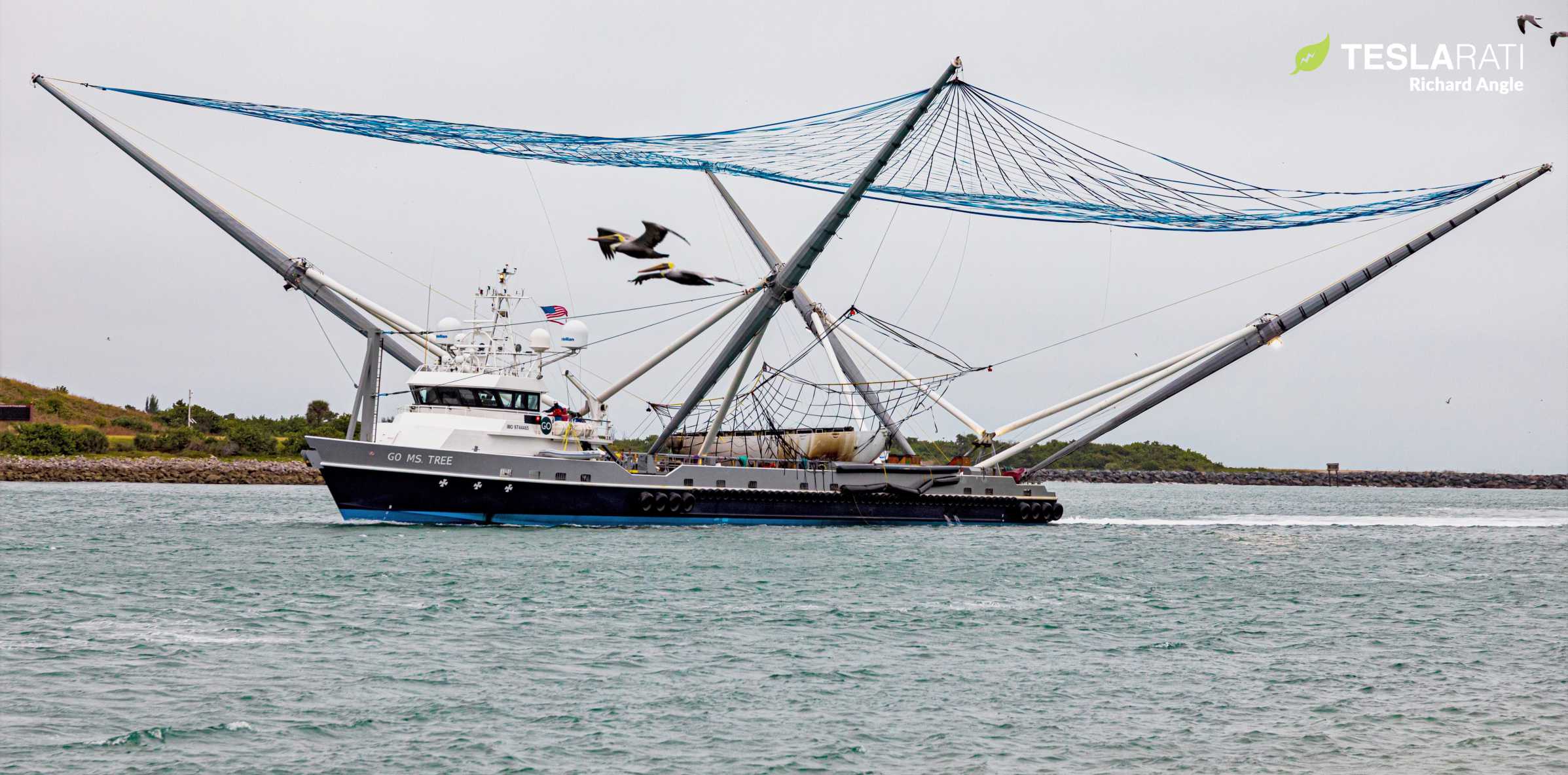
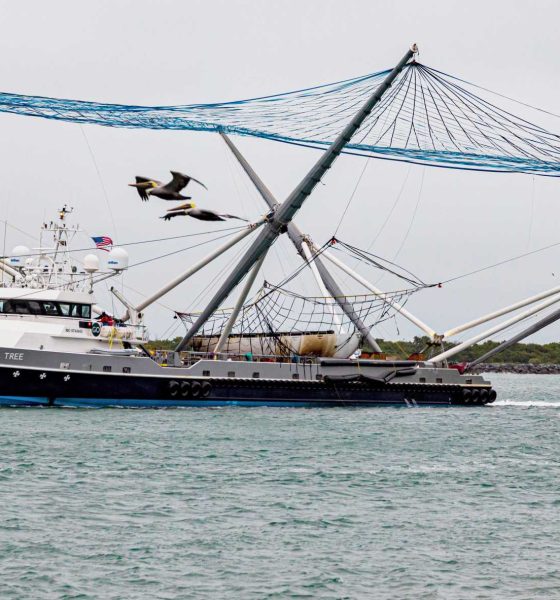
News
SpaceX fairing recovery ships return to port with Falcon 9 nosecone and battle scars
Four days after they headed out into the Atlantic Ocean, twin SpaceX fairing recovery ships Ms. Tree and Ms. Chief have returned to port with both halves of a Falcon 9 fairing, although they appear to have picked up some battle scars along the way.
Ms. Tree and its near-identical sibling Ms. Chief departed Port Canaveral on December 14th and arrived on station – 790 km (490 mi) off the coast of Florida – some 36 hours later. Each outfitted with a quartet of arms and pair of nets, it was the first time both ships successfully made it out into the Atlantic for a simultaneous fairing catch attempt, having been foiled by high seas during a prior November outing.
For unknown reasons, after the duo’s November false start, both ships stopped for almost two weeks at a South Carolina port, perhaps indicating that SpaceX was concerned about the structural integrity of the ships’ seemingly fragile net mechanism. In February 2019, Mr. Steven (now Ms. Tree) lost two of its four arms while heading downrange for an attempted catch, apparently broken off by pitching caused by high seas. Further strengthening the case that their net mechanisms are rather fragile, both Ms. Tree and Ms. Chief again suffered damage after their Kacific-1/JCSAT-18 Falcon 9 fairing recovery attempt.
Both ships arrived back at Port Canaveral on December 18th and were caught by Teslarati photographer Richard Angle while passing through the narrow mouth of the port. GO Ms. Chief took the lead, revealing a Falcon 9 fairing half snugly secured with a tarp on her deck – the ship’s very first launch vehicle hardware recovery.
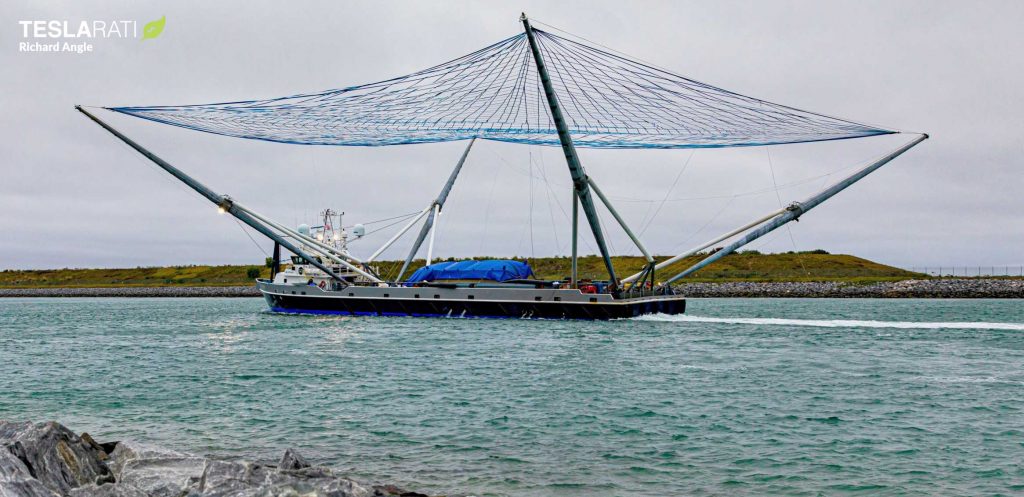
First (partially) successful fairing recovery quite literally under wraps, Ms. Chief nevertheless did not make it through the rite of passage unscathed. Oddly, it appears that just one of the ship’s eight white arm supports is missing (the rear right or aft starboard arm), visibly resulting in the arm slouching a bit compared to its siblings. Intriguingly, it appears that the arm is partially stretching – and thus potentially resting on – Ms. Chief’s net and rigging.
The fact that only one of the arm’s two beams (of eight total) seems to have failed is more immediately indicative of possible human error during installation or a defective attachment mechanism, although it’s entirely possible that a fluke of weather could have damaged just the one beam.
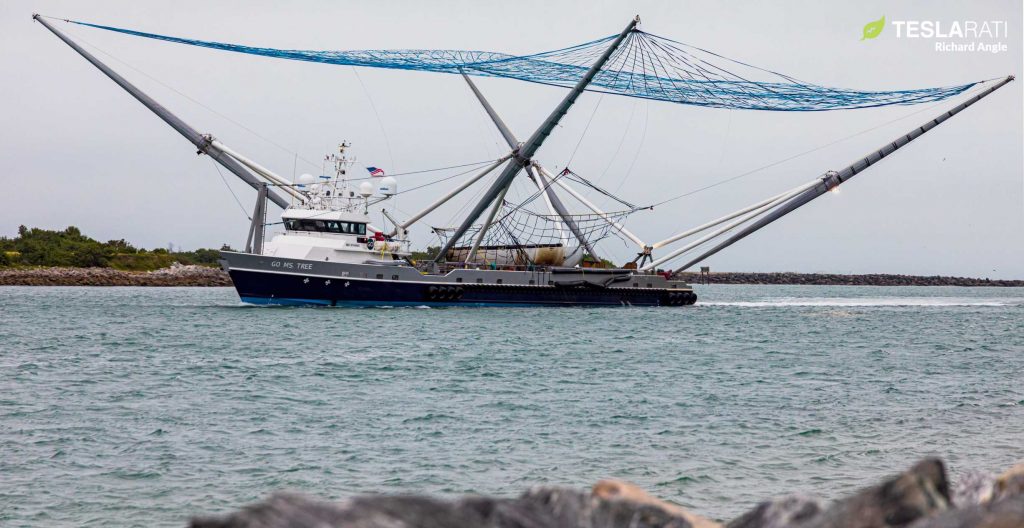
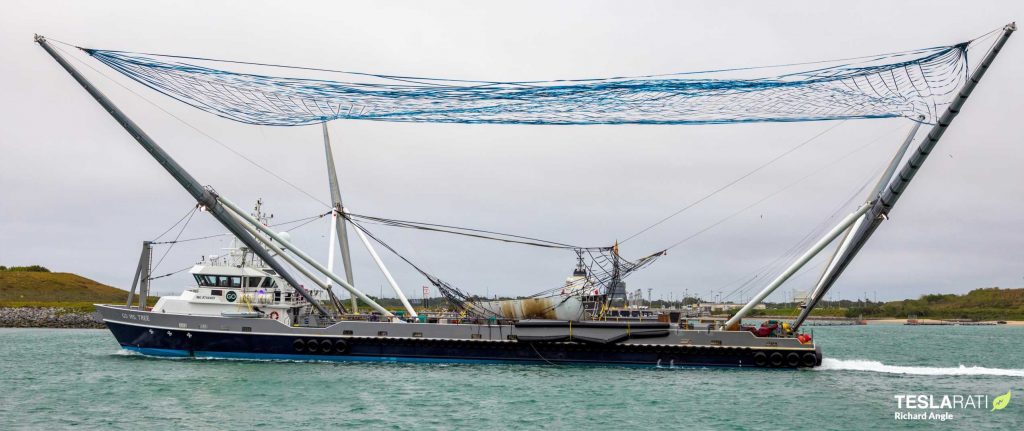
Thankfully, Ms. Tree (formerly Mr. Steven) appears to have made it through the recovery mission with all four arms fully intact, although the ship clearly struggled with a separate mechanism. Notably, Ms. Tree seems to have struggled to use its secondary net to lift its fairing half out of the sea and onto her deck, with that smaller net clearly suffering a multitude of rips and tears at some point during the process. Her recovered fairing half is somewhat awkwardly strewn on the deck with no obvious attempt to rectify the issue, indicating that the net may have torn mid-lift, causing the fairing to fall maybe 5-10 feet.
If it did actually fall onto Ms. Tree’s deck, that will almost certainly be visible in the form of damage to its aluminum-composite honeycomb structure and white insulation coating.
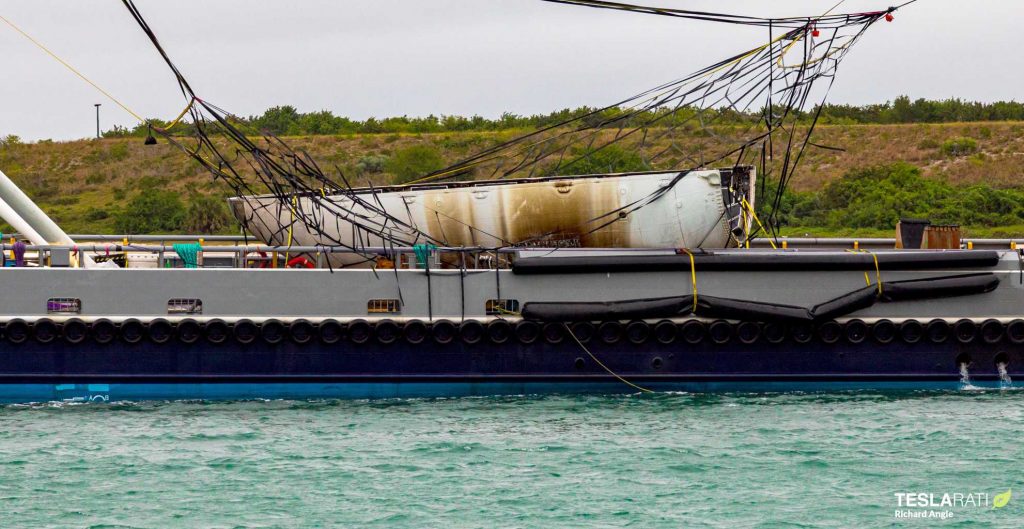
Ultimately, fairing recovery continues to prove itself to be a major challenge, although SpaceX obviously has no intention of giving up. With two successful catches already in hand, it’s clear that fairing recovery is undeniably possible and is more a matter of tweaking existing systems than starting from scratch. Much like Falcon 9 booster recovery had and its fair share of failed landings even after the first success, it will likely take quite a while for SpaceX to optimize fairing recovery to the point that it can be considered reliable.
For now, routine fairing recovery and reuse will likely continue to be Falcon 9’s white whale, at worst adding to the excitement of every SpaceX satellite launch.
Check out Teslarati’s Marketplace! We offer Tesla accessories, including for the Tesla Cybertruck and Tesla Model 3.

News
Tesla FSD earns high praise in South Korea’s real-world autonomous driving test
As per the Korea Expressway Corporation’s report, the FSD test was conducted on December 15, 2025, from 10 a.m. to 6 p.m.

Tesla’s Full Self-Driving (FSD) has received a bullish assessment from the Korea Expressway Corporation following a real-world autonomous highway driving test.
A report of the test, shared on Naver Cafe, showed high praise for the system’s safety, capabilities, smooth maneuvers, and confidence.
South Korean highway test
As per the Korea Expressway Corporation’s report, the FSD test was conducted on December 15, 2025, from 10 a.m. to 6 p.m. Four people were in the Tesla that was tested, including the head of the mobility department. All four FSD driving modes were tested, from “Sloth” to “Mad Max.”
To test FSD’s performance, the system was tasked to operate on highways such as Gyeongbu, Cheonan, and Cheonan-Nonsan, as well as city areas in Dongtan New Town, Sejong Special City, and Daejeon Metropolitan City, among others.
Since FSD is only available for the Tesla Model S and Model X that are imported to South Korea from the United States, the system was not tested in a Model 3 or Model Y, which comprise the majority of Teslas on the country’s roads today.
Highway test results
Results showed FSD performing well, both in inner-city roads and on highways. In inner city roads, the testers noted that FSD was capable of autonomous driving at a level that already exceeds that of general human drivers, except in very few areas, such as unprotected left turns and work zone intersections.
In highways, the testers described FSD’s performance as “excellent,” though the system still showed frequent cases of violations in local bus lanes and max speed limit rules. These, however, could hopefully be addressed by Tesla in a future FSD update without many issues. The testers also noted that in some parts of the test, FSD seemed to be driving autonomously in accordance with traffic flow rather than strict traffic rules.
테슬라 Fsd 고속도로 자율주행 테스트 결과 보고 by Simon Alvarez
News
Tesla claims nearly 20% market share as Norway sets new car sales record
Tesla captured roughly one in five new cars in Norway, highlighting its dominance in the world’s most EV-friendly market.
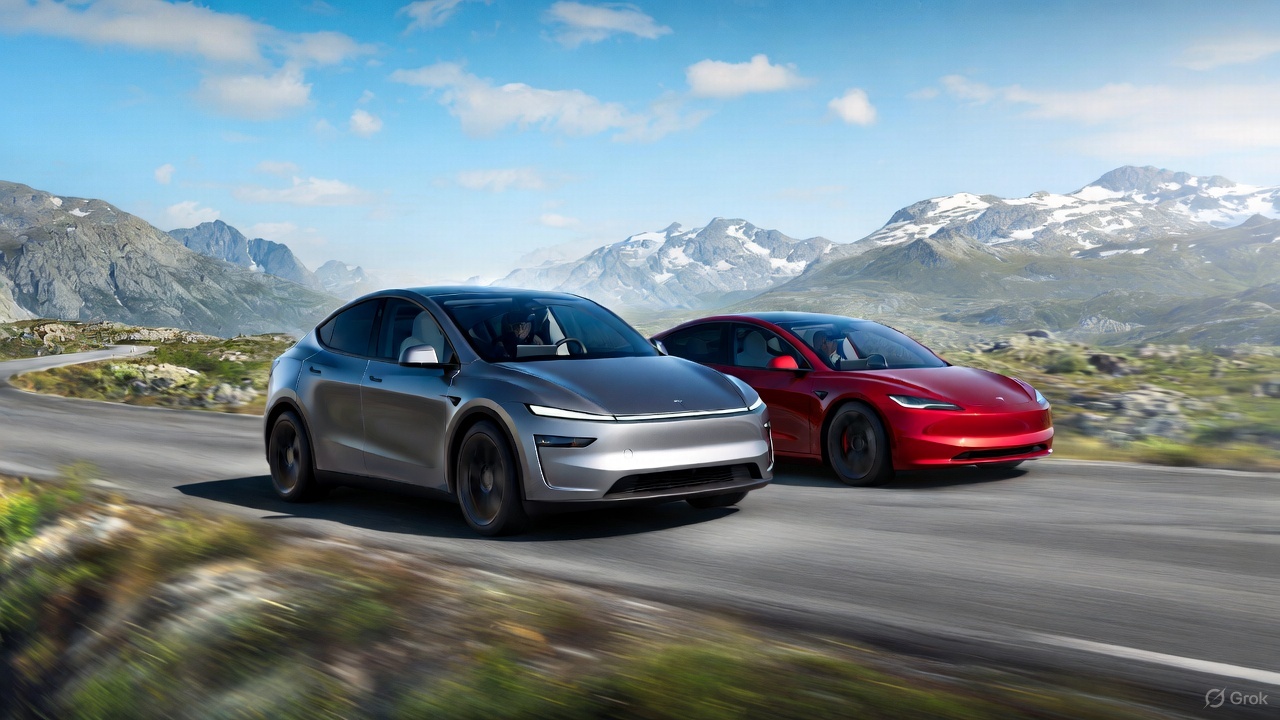
Norway shattered its all-time new car sales record in 2025, and Tesla emerged as the clear winner. A year-end rush ahead of higher EV taxes pushed registrations to nearly 180,000 vehicles, with electric cars accounting for 96% of sales.
Tesla captured roughly one in five new cars in Norway, highlighting its dominance in the world’s most EV-friendly market.
Norway’s EV rush
As noted in a CarUp report, Norway’s electric vehicle sales in 2025 surged, thanks in part to buyers rushing ahead of a post–new year VAT increase of roughly 50,000 kronor on many new electric cars. This ended up pulling demand forward and setting a national record with almost 180,000 registrations in 2025.
The result was unprecedented. From the vehicles that were sold in 2025, 96% of new cars sold were fully electric. And from this number, Tesla and its Model Y made their dominance felt. This was highlighted by Geir Inge Stokke, director of OFV, who noted that Tesla was able to achieve its stellar results despite its small vehicle lineup.
“Taking almost 20% market share during a year with record-high new car sales is remarkable in itself. When a brand also achieves such volumes with so few models, it says a lot about both demand and Tesla’s impact on the Norwegian market,” Stokke stated.
Tesla domination
Tesla led all brands in Norway with 34,285 registrations, which is equal to a 19.1% market share. These results place Tesla well ahead of Volkswagen and Volvo, which held a 13.3% and 7.8% market share in 2025, respectively.
On the model chart, Tesla’s strength was even clearer. The Tesla Model Y topped all vehicles with 27,621 registrations, accounting for 15.4% of the entire market. The Tesla Model 3 also ranked among the top five, accounting for 3.7% of Norway’s entire auto sales in 2025.
Other strong performers included Volkswagen’s ID.4 and ID.7, Toyota’s bZ4X, which commanded 4.9%, 3.9%, and 4.1% of Norway’s total sales in 2025, respectively.
News
Tesla China sees 2nd-best month ever by selling 97,171 vehicles wholesale in December
The results mark Tesla China’s second-highest monthly result on record, trailing only November 2022’s 100,291 units.

Tesla posted a sharp year-end rebound in China last month, with December’s wholesale figures climbing to their second-highest level to date.
The surge capped a late-year recovery for the electric vehicle maker, even as full-year wholesale figures still finished lower year over year. Still, the data highlights how Tesla China’s offerings still resonate with customers in the world’s most competitive electric vehicle market.
Tesla China’s December surge
Tesla China sold 97,171 vehicles wholesale in December, as per data from the China Passenger Car Association (CPCA). The results mark Tesla China’s second-highest monthly result on record, trailing only November 2022’s 100,291 units, based on data compiled by CNEVPost. The details of Tesla China’s December results, such as its domestic sales and exports, are yet to be released.
December’s wholesale results represent a 3.63% increase from the same month last year and a 12.08% jump from November’s 86,700 units. It also marked the second consecutive month of year-over-year growth, signaling renewed momentum in China.
Tesla’s late-year momentum is believed to be partly driven by Tesla pulling deliveries forward to allow buyers to take advantage of more favorable purchase tax policies before the calendar year ended. That strategy helped boost monthly performance even as competition in China’s EV market remained intense.
Tesla China’s FY 2025 volumes
Despite the strong December finish, Tesla China’s wholesale sales declined on an annual basis. The electric vehicle maker’s total wholesale figures for 2025 reached 851,732 units, down 7.08% year over year. This could have been due to a variety of factors, from intense competition in the domestic Chinese market to Giga Shanghai’s changeover to the new Model Y in the early part of the year.
Tesla Gigafactory Shanghai continues to play a central role in its global operations, producing the Model 3 sedan and Model Y crossover for both Chinese customers and export markets. The efficiency of Gigafactory Shanghai has allowed it to become Tesla’s largest factory by volume, as well as the company’s primary vehicle export hub.







